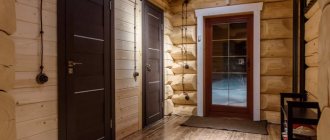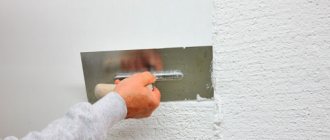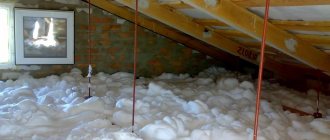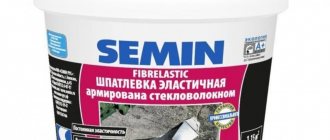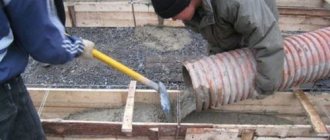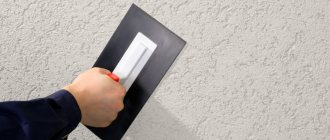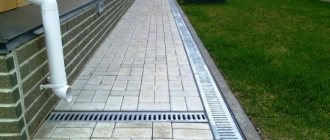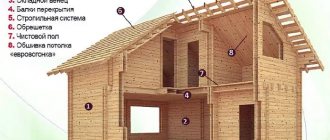Self-expanding polyurethane is easy to apply and provides significant reduction in thermal conductivity
Foam for wall insulation is used in thermal insulation work quite often. This material is characterized by an optimal combination of ease of application and good performance characteristics.
Of course, to realize these advantages, you need to strictly follow the technology, so below we will analyze in detail both the main types of thermal insulation foam and the algorithm for working with them.
How to insulate a house and why - insulation for a house without consequences
Why do our clients order ecofoam insulation? What exactly motivates them not to use traditional insulation? The picture, as always, is very simple. An example from one of our clients (we filmed a whole video story under this post): the house was initially insulated with mineral wool. After insulation, it was discovered that the cotton wool was getting wet. This became especially noticeable when the walls were plastered. The customer decided to dismantle the mineral…
What is the best way to insulate an attic roof?
Roof insulation Ecopen, PPU, Polyurethane foam There is a huge selection of polyurethane foams on the market and the question often arises: which insulation for a home is better. There are two types of foams: hard foam and soft foam. Their density differs: one foam has a density from 10 to 20 kg/m3, the other has a density from 30 to 60 kg/m3. Solid foam (high-density polyurethane foam) has ...
How to insulate the attic roof of your house during construction?
When you are building a house and at the same time thinking about how to insulate the attic, many additional questions arise: 1. Is a ventilated gap under the roof space necessary? 2. How to properly lay a hydrobarrier (diffusion membrane) 3. Which insulation should I choose? 4. Which vapor barrier should I choose to isolate the insulation from water vapor that tries to escape from the room during the operation of the house? Need...
Area of use, recommendations for selection
Construction foam is a universal insulation material. However, due to some differences in the properties of various compositions, it is better to use a specific variety in one case or another. For this there are the following series of recommendations:
- Cracks, defects, and cavities during the installation of windows and doors are sealed with polyurethane. In this case, the frozen material must be protected from direct sunlight.
- Filling the large inter-wall volume of frame structures is carried out using penoizol. Used both externally and internally to form an insulating seal in walls and floors between sheathing sheets.
- Elimination of small-sized irregularities, cracks, seams, and cavities is done using polyurethane foam. For example, when installing solid insulating panels, arranging a foundation, installing windows.
Sealing defects with polyurethane foam Source yandex.net
Polyurethane liquid foam for insulating walls, attics, roofs, and basements creates reliable protection with good waterproofing performance. Spraying is carried out using special equipment. However, if the volume of similar work is small, then it is quite acceptable to use polyurethane foam from cylinders.
What is penoizol scientifically and where did it come from?
The Germans are considered the creators of penoizol. It was they who, in the thirties of the last (XX) century, synthesized urea with formaldehyde and obtained liquid foam. Today it is made and used differently than ninety years ago. The technology of its production at that time was so serious, complex and problematic that thermal insulation of houses and cottages with it was out of the question. Too expensive! Two decades later, the Germans conducted a series of studies and found that it could be obtained much easier. Reducing the cost of foam insulation has made it accessible to private homeowners.
In the mid-twentieth century, more precisely in the 50s, penoizol was already widely used in the thermal insulation of private houses and cottages in France, Austria, Germany, and even Japan. For residents of the Commonwealth of Soviet Socialist Republics or simply the USSR, it was inaccessible for a number of reasons. The price tag, cosmic for an ordinary person at that time, automatically endowed it with magical, miraculous characteristics. In addition, in the post-war country, penoizol was used in the aviation and rocket industries. It was impossible to get it even for those who lived, as they say, in abundance.
At the end of the era of Secretary General Brezhnev, the military began to use liquid foam. There is a version according to which penoizol was poured between the walls of strategically important objects for conspiracy. It was used to insulate cold armored weapons depots, metal hangars for fighter aircraft, workshops, factories, and service stations for special equipment. A factor in the rapidly growing popularity of penoizol was and remains the list of technical characteristics. One of the priority properties is unsurpassed fire resistance of class “G2”, as well as compliance with the interstate Russian standard “GOST 30244-94”.
Foam cost
If you buy a cylinder at retail, then on average you can pay 300-500 rubles per piece. But this type of insulation is rarely purchased separately. Usually its cost is included in the cost of work:
- polyurethane foam - about 100 rubles per linear meter;
- penoizol - 700−2000 rubles per cubic meter;
- polyurethane - 3000−5000 per cubic meter.
The price of the material also plays a big role in its selection. But you shouldn’t skimp on high-quality thermal insulation if you need to insulate your home for a long time for a comfortable stay.
Foam insulation is suitable for most walls , including panel, block and aerated concrete. Therefore, they can be safely used as insulation for apartments and private houses. What type of foam to choose is a purely personal matter for everyone. But first, it still doesn’t hurt to find out more about the selected composition, read reviews, and get advice from a salesperson at a hardware store. It is not recommended to use loose-fill insulation, which easily catches fire, unlike the foam fireproof version. And it is not the most convenient to use, the only exception being the floor surface.
Insulation with liquid foam is a better solution , because if desired, this procedure can be carried out independently, without the help of specialists. If you do everything correctly and are careful, you will be able to quickly insulate any surface that needs it.
Technical characteristics of penoizol - list
- thermal conductivity coefficient according to “MCE” – from 0.028 to 0.044 W/m*Kelvin;
- compressive density at relatively weak (no more than 10%) deformation – 0.003 MPa;
- resistance to temperature changes in degrees ℃ – from +70 to 55 with a minus sign;
- the volume of suspended particles of liquid and volatile ingredients is not higher than 12%;
- tolerance to aggressive environments – mold and fungal growths;
- acoustic barrier and noise reduction potential – from 20 to 60 decibels;
- the average density of a thermal insulation cushion is from 10 to 30 kg/m3;
- compression level providing support for the initial shape - 0.07-0.55 kg.cm2;
- repels small insects, voles, rats, and other pests;
- sorption humidification during the day (24 hours) – no more than 20% (twenty);
- resource guaranteed by the manufacturer – from 75 (min.) to 120 (max.) years.
Types of penoizol and use in thermal insulation
People who are poorly informed about it mistakenly believe that white foam, similar to a delicacy from distant childhood, is the only form of urea-formaldehyde foam. In fact, it comes in three variations. The most popular and objectively in demand is the liquid form of penoizol, which some craftsmen obtain using artisanal methods. Penoizol can indeed be prepared at home, but we categorically do not advise you to do this for reasons of basic safety. Mistakes when working with hazardous chemicals can cost you much more than you realize.
Performance characteristics of polyurethane foam: pros and cons of the material
A large assortment of materials for thermal insulation complicates the selection process, but at the same time allows you to select insulation with ideal parameters for a particular object, taking into account its operating conditions, purpose, as well as the type of building materials from which the walls, ceilings and other structural elements of the building are constructed.
Therefore, when choosing polyurethane foam for your home, you need to take into account all the positive and negative properties of this insulation.
Harmfulness of penoizol and impact on human health
Get straight to the point! In the United States of America, as well as Canada, it was banned for use at the official state level for a long time. Later, researchers proved that during operation, liquid foam does not emit carcinogens and is therefore safe. As a result, the ban was lifted. Russian factories, which simultaneously act as suppliers, claim that this insulation is not inferior in safety to steak sawdust and ecowool. In England, the use of urea-formaldehyde insulator in the thermal insulation of residential buildings is permissible only with a special document in the form of permission from regulatory authorities.
Algorithm for thermal insulation work
Insulating a house with polyurethane foam can be carried out either using professional generating equipment or using special kits. The kit includes:
The thermal insulation shell is applied to a large surface area using professional equipment
- Components for the formation of foam in cylinders.
- Hoses for connection.
- A gun that is used to mix reagents and spray foam.
A set of equipment for performing thermal insulation on your own
In addition, some manufacturers include personal protective equipment in the kit - gloves, goggles and a respirator. You should not forget about them: during the polymerization of even the most environmentally friendly brands of foam, volatile phenols and other toxins can be released.
You need to work in personal protective equipment
Foam insulation for walls is applied as follows:
| Illustration | Work stage |
| Preparing the kit. We open the boxes with cylinders, but do not remove the containers themselves - this makes them easier to carry. We insert the supplied hoses into the holes in the boxes. | |
| Connecting hoses. We attach hoses with union nuts to the fittings on the cylinders. We tighten the connections with a wrench, sealing the elastic sealing gaskets. | |
| Test blow. We attach the dispenser gun to the hoses. After this, we blow a small amount of foam into an empty container: we need to fill the hoses, displacing the air from them, and achieve uniform mixing. | |
| Preparing the pistol. We put a nozzle on the nozzle for pouring or spraying. We check that there is no gap between the nozzle and the body. | |
| Foam spraying. Spray the foam insulation evenly over the insulated surfaces. We apply the material in several passes, each time giving time for expansion and primary polymerization of the material. |
Comparison of penoizol with other insulation materials
The fire resistance of penoizol is superior to foamed polyurethane. It does not ignite even with prolonged contact with open flame. This is facilitated by thermosetting resin, which, when interacting with flames, forms an infusible material. As for polyurethane foam, its flammability in classes “G1” and “G4” is determined by aluminum fire retardants. Upon contact with open areas, polyurethane foam is destroyed, loses its ability to withstand flames, melts and can ignite. In terms of service life, sprayed polyurethane foam is also inferior to liquid foam made from urea-formaldehyde ingredients.
The most serious competitors of penoizol, in our opinion, are ecowool (dry cellulose) and crumbly sawdust steak. These environmentally friendly insulation products are the best on the market. They are made from wood fibers. They do not contain chemicals, except for antiseptics and fire retardants - products that are harmless to health. Meet international quality standards. They work better than any insulator, as they penetrate hard-to-reach points, crevices and depressions with a diameter of up to 0.01 millimeters. For objective reasons, they are officially approved for use in all countries of the world without any restrictions.
According to international statistics, in Europe, from 0.5 to 1.5 million residential houses, cottages and townhouses are insulated with ecowool. Americans use ecowool and sawdust every quarter to insulate 150,000 buildings and structures. As sad as it is to state, the “stupid” inhabitants of the notorious America, as Mr. Zadornov called them, have long been superior to us Russians in their knowledge of ecology. It is ecowool in the West that is considered the number 1 insulation material. Neither penoizol, nor polyurethane foam, much less basalt insulator, can compete with it. If you, as a reader, do not agree with this statement, please write your view of the situation in the comments to this article. Thank you!
Do-it-yourself insulation
To make high-quality thermal insulation of a house with foam, while ensuring the safety of the wall material with a guarantee, only a real professional team can do. For those who decide to perform the procedure themselves, we can recommend the following instructions:
- The sheathing is screwed or nailed to the outer sides of the house wall. The slats, 2-3 cm thick and 7-10 cm high, are mounted edge-to-plane. Horizontal and vertical crossbars should form hollow cells with dimensions of 0.5 by 0.5 meters.
- Before starting work, the user puts on a protective suit, gloves, goggles, and a respirator.
Insulation of walls with polyurethane foam Source stroy-podskazka.ru
- The spraying equipment is brought into readiness, the container is filled (foam for wall insulation in cylinders is connected to the gun), its serviceability and performance are checked.
- The cavities of the sheathing are filled from edge to center with foam, taking into account its subsequent expansion - in full accordance with the instructions from the manufacturer.
- Upon completion of the work, the material is given time to completely harden.
- The frozen mass is leveled and finished with panels, sheet materials or plaster.
It is important to know! The choice of modification and foam manufacturer depends on the preferences, conditions of use and financial capabilities of the individual user. For example, you can simply foam the walls of your house with polyurethane foam. However, before starting work, it is recommended to find out as much information as possible about the composition used - from the seller, on the manufacturer’s website, in reviews, from craftsmen. It is better to give preference to a more reliable, safe and high-quality composition.

